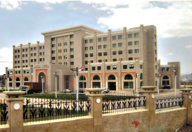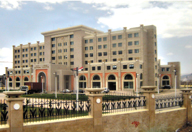
The new face of Sana’a [Archives:2008/1161/Last Page]
May 5 2008
 |
Nearly everyone notices that Sana'a is receiving a makeover. Construction and infrastructure development has been expanding since the 1990s, giving historical Sana'a a facelift and transforming the city – albeit slowly – into a modern metropolis.
Residents can see the construction, spanning everywhere from east to west and north to south, beginning to eat up the rural landscape and the mountains surrounding the city. Not only is Sana'a getting new buildings, but also a surface expansion and infrastructure projects such as roads, schools, hospitals, electricity and water networks.
Construction is expanding at a record pace in Sana'a
Sana'a is on the receiving end of increasing local migration from all Yemeni governorates and now has more than 2.5 million inhabitants, according to the Central Statistic Organization's (CSO) last survey in 2004.
The capital city also is a destination for those seeking better employment opportunities; thus, Sana'a is attempting to sustain all of its new residents. To help manage the situation, new buildings are being constructed across the city.
Investors have begun turning their attention to the outskirts of the city, where they can build modern homes and large buildings on open land. Areas in western Sana'a like Aser, Assounainah and Madhbah were desolate and uninhabited as recently as 10 years ago.
Expansion also has extended south to Assawad, Haddah village and Attan areas, which were just vacant borders of the capital city a decade ago.
Construction to the north has reached Arhab, which borders Amran governorate and promises to continue in that direction, while eastward expansion now has reached its end at Nuqum Mountain.
Yemen's capital city, whose tallest buildings once were found in its Old City section, now has structures 15 floors high and made of expensive stones imported from the Yemeni countryside. Brought in from such places as Dhamar, Rada'a, Marib and Hodeidah, they are named for their governorates, such as Dhamari, Rada'i and Maribi.
The most famous of the tallest buildings comprising the new face of Sana'a are Sana'a Tower on Zira'a Street, Ribat Tower near Hayel Street, the Zaid Al-Qubati building on Baghdad Street and the Lailah Illa Allah Building Right building on the Al-Dhairy and Zubairy crossroads. Built of white and red stones, these new buildings and towers are constructed with a very advanced and unique architecture.
The newest and most beautiful buildings and construction reflecting the uniqueness of Sana'a construction are the new Foreign Ministry building in the Siteen-Aser area, the Movenpick Hotel in Nuqum and the Oil Ministry building on Zubairi Street. These buildings are built of the most expensive and beautiful marble in Yemen, which is Hanashi or Rada'i, from Rada'a. The color of this type of marble is reddish-gray.
Besides these beautiful buildings and towers, others like Al-Asimah Tower on Hadda Street currently are under construction.
According to the CSO, there are 164,421 buildings in the capital secretariat, 49,194 of which are constructed of stone, while 22,864 are made of stone exeriors, 12,349 are made of mud brick and 64,378 are made of concrete blocks and bricks.
According to Khalid Al-Madani, owner of Al-Madani Stone Workshop, the best and most expensive type of decorative stones are red and gray ones brought from Rada'a and called Hanashi. A single stone measuring 25 x 25 x 7 centimeters costs YR 250, whereas other types cost YR 200 for the same size.
Where there's construction, basic services also are needed
Health service also are increasing and expanding in response to the increasing needs of the capital city's ever-growing population. According to Dr. Adel Assamiee, information management director at the Public Health and Population Ministry, Sana'a has some 121 hospitals, with numerous others currently under construction.
As the Yemeni population centralizes in the capital city, traffic jams have increased, so the government is increasing the number of strategic projects such as tunnels and bridges at Sana'a's main major crossroads.
In this regard, Amin Juma'an, secretary-general of Sana'a's local council, notes that five tunnels have been constructed at Sana'a crossroads in an effort to ease problems, while eight others remain under construction.
The largest and most important of these strategic projects is the Yemeni-Chinese Friendship Bridge at the crossroads of Zubairi Street and Bab Al-Yemen near Safiah and Tahrir Square.
New roads have been built and others still are underway in an effort to keep pace with the widespread construction and help ease traffic jams resulting from the more than 260,000 vehicles in Sana'a.
One major road project involves Siteen Street, which is 60 meters wide (this is where the street gets its name). The street will extend around Sana'a from Al-Rawdha area in the north to Taiz Street in the south of the city.
Additionally, another 50-meter-wide street is being constructed around Sana'a, stretching from Amran Road in the north, crossing Aser in the west and ending at Beit Baws in the south. The street primarily will be for large trucks in an effort to decrease noise within the city center.
The advantages of this construction boom are the beautification of the capital city and the opportunity to display Yemen's unique stones and building style, which draws the attention of many foreign visitors to Sana'a.
Disadvantages
Such expanded construction in Sana'a also has consumed many agricultural lands, including 5 to 8 square kilometers of acreage north of the city in Al-Rawdha and Shamlan areas. This spread can affect climate change if rural areas are gobbled up by construction.
Another disadvantage of this expansion is pollution. Besides the 260,000 vehicles in Sana'a, construction exhaust and asphalting of roads also create pollution in the capital city.
Additionally, CSO statistics indicate that 7,881 industrial facilities and more than 62 stone workshops serve to increase this problem. As stones are cut and shaped in these workshops, dust goes into the air causing air pollution. The same goes for other industries such as carpentry and chemical spraying.
Sana'a environmental director Sharaf Al-Hamazi notes that the increasing population, vehicle exhausts and construction all lead to environmental pollution.
“Respiratory disease have increased due to diesel machinery, which is the main cause of pollution in Sana'a,” Al-Hamazi says, adding that, “Work such as cutting and shaping stones in workshops and constructing roads and tunnels are other causes of pollution.”
However, he adds, “We're working to plant more trees and conducting pollution awareness programs in order to contain this problem.”
——
[archive-e:1161-v:18-y:2008-d:2008-05-05-p:lastpage]


